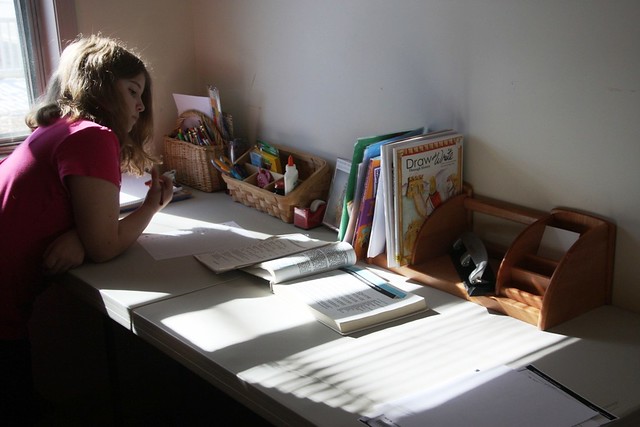
Articles
Editor’s Picks
K-12
Homeschooling and Its Online Learning Market Are Fast-Growing, but Hardly Understood
By Henry Kronk
August 04, 2019
Stanly County Schools, a district roughly an hour outside of Charlotte, N.C., is in a unique situation. According to the Stanly News & Press, overall enrollment is down 12.5% over the past decade, while the homeschool population has grown by 112%. In a district with 8,226 students, an estimated 1,186 other kids are learning at home. That’s nearly 15%. To help with this surge, the district has developed Stanly County Virtual Education (SCoVE). The virtual learning center allows students to take remote online high school courses as needed throughout their K-12 years.
Homeschooling across the U.S. has grown almost as quickly as in Stanly County. The National Center for Education Statistics (NCES) estimates the population stood at 850,000 households in 1999 and ballooned to 1,773,000 in 2012. It then unexpectedly shrank to 1,690,000 in 2016 (more on that later).
The country of Canada, furthermore, is in the same boat as Stanly County: since 1999, public school enrollments have declined, while homeschooling has risen. Homeschooling in Manitoba grew 140% between the 2007-08 school year and 2014-15. Still, homeschooling rates as a percentage of the population are about half in Canada compared to the U.S.
Most of What We Know About Homeschooling Is Projected from a Sample of Less Than 650 Households
The NCES compiles data on homeschooling households via the National Household Education Surveys (NHES) Program. The program collects information every four years. The last one occurred in 2016. Besides total population, they also track things like annual household income, race, grade of learner, and details about parents, such as education and relationship status.
As of 2016, the majority (59%) are White, followed by 26% Hispanic, 8% Black, and 7% are Asian, Native American, Pacific Islander, two or more races, or other. Most (54.2%) earn between $20,000 and $75,000. The greatest portion (38.5%) live in a suburban locale, although the homeschooling rate was highest in rural areas (4%).
Among parent teachers, 30.2% have a high school diploma or less; 24% have a technical or vocational degree or some college; 29.6% have a bachelor’s degree; and 15.4% have a graduate or professional degree.
But this data is not 100% reliable. NCES figures represents an estimate projected from a sample size of usually between 15,000-20,000. As a NCES report on the profile of American homeschoolers in 2012 relates, “NHES data are designed to measure phenomena that cannot be easily measured by contacting institutions such as schools but are efficiently measured by contacting people at their homes.”
The 2012 NHES data—the latest for which there is a detailed report—reached 17,563 households. The program includes numerous questionnaires, and homeschooling data comes from responses to the Parent Family Involvement in Education (PFI) survey. There are two versions: the PFI-Homeschool and PFI-Enrolled. The NHES received 347 responses from homeschooling households to the former and 303 from the latter. The data projected on to the scale of the U.S., therefore, comes from just 650 survey responses. Many families, furthermore, filled out both, so the total sample is even smaller.
What’s more, the PFI prior to 2012 was conducted by a researcher speaking with households over the phone. As of 2012, the survey switched to “Address Based Sampling frame and mail self-administered data collection instruments.”
As such, the authors write, “Changes in estimates reported between 2012 and prior reporting years could be the result of changes in the population or in the data collection approach.”

Why Do Families Homeschool?
The practice has the reputation of appealing to families seeking to combine religion with their children’s instruction. But the NCES estimates indicate that this isn’t necessarily the case. The PFI surveys ask households why they choose to homeschool. Common reasons include: providing religious instruction; providing moral instruction; concerns about the school environment (e.g. drugs, safety); quality of public school instruction; the wish to provide kids with an alternative education; tailoring to needs of kids with individualized education plans (IEPs); and ‘other.’
Among these, the most popular concern in 2016 was environment and safety, with 80% of respondents flagging it as important and 34% saying it was the most important factor in their decision. By measure of ‘most important reason,’ environment was followed by quality of instruction at other schools (17%), and religious reasons (16%). Still, just 51% of households said providing religious instruction was important.
So while homeschooling has been a popular decision in religious communities historically, the current population is more concerned about providing a safe, quality learning environment.
Online Learning Is Growing in Popularity Among Homeschoolers
Data from the 2016 PFI report is available in a ‘first-look’ version only. But based on the 2012, it is clear that more and more homeschool households are using online learning and virtual instruction to augment their education, especially during secondary years.
Over one-third of middle (35%) and high school (34%) age learners took at least one online course as part of their instruction. Even K-5 learners were taking online courses at a rate of 11%.
Many learners accessed these online courses through existing institutions. The source of the virtual instruction runs as follows: 11% from a local public school; 20% from a different public school; 22% from a charter school; 21% from a private school; 12% from an institution of higher education; and 16% from the state. The largest category, however, was ‘other.’ A full 41% of the homeschoolers taking an online class did so from some provider that was not described by the listed categories above.
What’s more, many of these data points are even less reliable than other information presented, and have a coefficient of variation of 30% or more.
Again, this information derives from fewer than 650 respondents in 2012. In the years since, the MOOC craze has lived and died, virtual charter schools have greatly expanded, numerous districts have created their own virtual learning centers (like Stanly County), and countless other developments have occurred in the online learning and virtual instruction space.
Next to Nothing Is Known about the Homeschool-Facing Online Learning Market
While these projections need to be taken with a grain of salt, even less is known about the market of online learning providers serving these households. While many online learning providers cater to a wide population that includes homeschoolers, others focus specifically on the homeschool market.
Calvert Education Services, for example, specializes in blended learning curriculum specifically for homeschooling families. The company was sold last week to Edmentum for an undisclosed sum. Many virtual charter, private, and public schools also make their courses available to homeschoolers.
Little-to-no analysis has been done on this segment of the online learning market. That is likely due to how difficult it is to study compared to the value of such information.
By comparison, much is known about the virtual charter school market. In the 2016 school year, 295,518 American K-12 learners enrolled in a virtual charter school. There are more than five times that figure in homeschool households, many of which include multiple learners.
One might expect there to be interest in a market of that size. But for now, online learning providers looking to enter the homeschool-facing market are mostly in the dark.
Featured Image: Kelly Sikkema, Unsplash.









One Comment